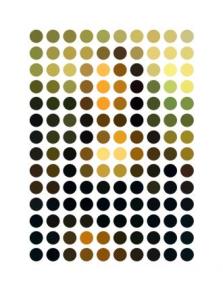 This pointilist images puts me in mind of some fundamental ideas of information theory.
This pointilist images puts me in mind of some fundamental ideas of information theory.
Even though you are seeing a limited set of data here, 140 dots, each of uniform color, it is fairly clear what this image represents. (Hint: standing a bit farther back might help!)
A fundamental concept in information theory is the compression of information. Suppose you want to communicate something, like a painting: a mathematical way to do this would be to describe the color of each pixel, in some order. That would require the transmission, reception, and translation of millions, or even billions, of numbers.
Here we see a very complicated and intricate image being communicated with a very small set of data. Finding more efficient ways to pass along (and store) information is more important than ever before, and is a focus of much modern mathematics.
Of course, recognition of this image relies on the experience of the viewer, who must bring the appropriate context to this information in order to decode it. But that is required in all successful communication.






